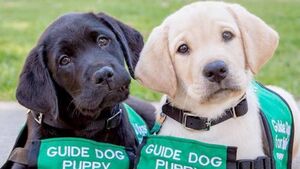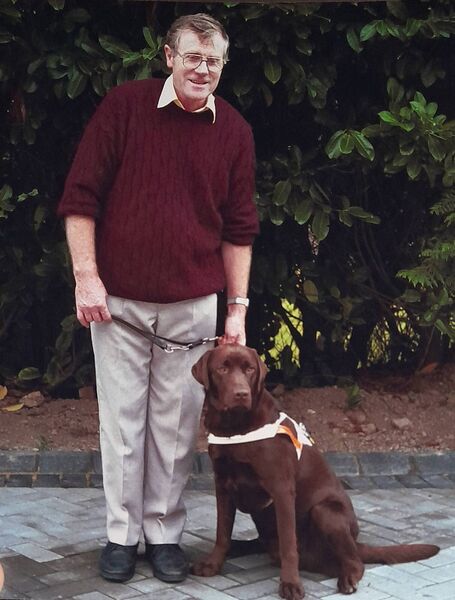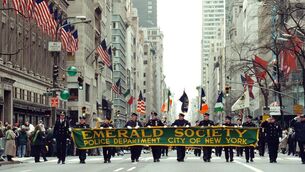The guide dog is truly a man’s best friend

Guide dogs provide a vital service to the visually impaired.
In a former life, I worked for Irish Guide Dogs for the Blind (IGDB). It is a terrific organisation, based in Cork, providing dogs to guide the blind and visually impaired. There are few partnerships as impressive as an animal and a human being working together; the horse and jockey, the shepherd and sheepdog, but most magically, the sight of a dog leading a blind person along a quiet country lane or a busy city street.
During my time with IGDB, I knew a few people who lived in rural areas who benefited from having such a dog. One of those people was the late Liam Gillard who lived near Bonniconlon. As well as being a proud guide dog owner, Liam was a renowned local historian.
In terms of world events, the birth of the guide dog service is relatively recent and like many great developments, it happened almost by accident. It was also one of those positive things that grew out of a most terrible situation.
The first known example of a special relationship between a dog and a blind person was depicted in a first-century AD mural in the ruins of Roman Herculaneum. While this may be the first example, it was not until the aftermath of World War I that the concept we are familiar with today began to emerge. The International Guide Dog Federation takes up the story, outlining the enduring relationship that seemed to have formed so naturally.
Dr Stalling started to explore ways of training dogs to become reliable guides, and in August 1916 opened the world’s first guide dog school for the blind in Oldenburg. The school grew and many new branches opened in Bonn, Breslau, Dresden, Essen, Freiburg, Hamburg, Potsdam, Münster and Hannover, training up to 600 dogs a year. These schools provided dogs not only to ex-servicemen but also to blind people in Britain, France, Spain, Italy, the United States, Canada and the Soviet Union.
Around this time, a wealthy American woman, Dorothy Harrison Eustis, was already training dogs for the army, police and customs service in Switzerland. It was to be Dorothy Eustis’s energy and expertise that would properly launch the guide dog movement internationally. The International Federation picks up the story.
As a result of these interventions, Frank got the first guide dog in United States and that country went on to become trailblazers in the growth of the guide dog service. Such dogs in the United States are today known as Seeing Eye Dogs.
The guide dog story started in Britain in 1931 with two talented British pioneers, Muriel Crooke and Rosamund Bond. These remarkable women organised the training of the first four British guide dogs from a humble premises in Wallasey, near Liverpool. However, it wasn’t until 1976 that the Guide Dog service came to Ireland. Up to that time, any guide dogs working in Ireland had come from the British service.
Information provided by IGDB takes justifiable pride in their work in providing guide dogs for the blind and the visually impaired of Ireland since that time.
In Ireland, IGDB’s programmes are offered free of charge, with intensive support and aftercare available to all their clients. Milestones along their journey to success include:
1976: organisation founded by Mary Dunlop and Jim Dennehy;
1980: opened the Model Farm Road, Cork site and trained their first guide dog partnership;
1988: introduction of the Orientation and Mobility Programme (Long Cane Training);
1999: introduction of the Child Mobility Programme;
2005: introduction of our Assistance Dog Programme for families of children with autism.

I often had occasion to visit Liam Gillard, at his home near Bonniconlon. My memory of him is walking back from his cattle shed, being led by his faithful dog, Craig. Craig was an adorable chocolate Labrador, whose laid-back style made him the perfect guide dog for a rural location. Liam and Craig were a great team; they had huge respect for each other.
When they got back to the house, Liam would take up a position in his favourite chair for a long chat, usually about family history or some aspect of local heritage. I remember one story he used to tell about a local woman who had the reputation for keeping an excellent vegetable garden. Liam would relate how this woman’s garden fed a whole village at the time of the Famine. While potatoes suffered from blight, there was no such impediment to the growth of onions, turnips, carrots and cabbage. And so, there was full and plenty for those who lived near the woman’s garden. All through this conversation, Craig would stretch, off duty, in his comfortable bed until he was called on again to guide Liam to his next destination.
Liam is now gone to his eternal reward, as is his faithful friend, Craig, but I have no doubt they are both in comfortable places in Heaven’s kitchen. Liam is likely regaling the assembly with a piece of local history and Craig, asleep at his feet, is dreaming of the happy days they spent together close to the Ox Mountains.
IGDB is a registered charity that depends on voluntary donations. Its service is provided to all users free of charge. Go to www.guidedogs.ie to find out more about its services or to make a donation.





